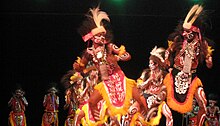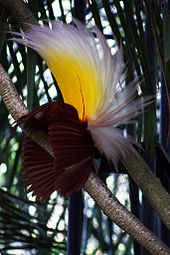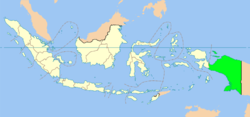Papua (Indonesian: Provinsi Papua) is a province of Indonesia. It comprises most of the western half of the island of New Guinea and nearby islands. Its capital is Jayapura. It is the largest and easternmost province of Indonesia.
The province originally covered the entire western half of New Guinea. In 2003, the Indonesian government declared the westernmost part of the island, around Bird's Head Peninsula, a separate province; its name was first West Irian Jaya and is now West Papua: the remaining part retained the name, Province of Papua.
| Papua Province Provinsi Papua |
|||
|---|---|---|---|
| Province | |||
| Province of Papua | |||
|
|||
| Motto: Karya Swadaya (Sanskrit) (Work with one's own might) |
|||
| Location of Province of Papua in Indonesia | |||
| Coordinates (Jayapura): 2°32′S 140°43′ECoordinates: 2°32′S 140°43′E | |||
| Country | |||
| Capital | Jayapura | ||
| Government | |||
| • Governor | Lukas Enembe[1] | ||
| Area | |||
| • Total | 319,036.05 km2 (123,180.51 sq mi) | ||
| Population (2010) | |||
| • Total | 2,833,381 | ||
| • Density | 8.9/km2 (23/sq mi) | ||
| Demographics | |||
| • Ethnic groups | Papuan, Melanesian (including Aitinyo, Aefak, Asmat, Agast, Dani, Ayamaru, Mandacan Biak, Serui), Javanese, Bugis, Mandar, Minangkabau, Batak, Minahasan, Chinese. | ||
| • Religion | Protestantism (65.48%), Roman Catholicism (17.67%), Islam (15.89%), Hinduism (0.09%), Buddhism (0.05%) | ||
| • Languages | Indonesian (official), 269 indigenous Papuan and Austronesian languages[2] | ||
| Time zone | EIT (UTC+09) | ||
| Website | www.Papua.go.id | ||
Naming
"Papua" is the official Indonesian and internationally recognised name for the province.During the Dutch colonial era the region was known as part of "Dutch New Guinea" or "Netherlands New Guinea". Since its annexation in 1969, it became known as "West Irian" or "Irian Barat" until 1973, and thereafter renamed "Irian Jaya" (roughly translated, "Glorious Irian") by the Suharto administration.[3][4] This was the official name until the name "Papua" was adopted in 2002. Today, natives of this province prefer to call themselves Papuans.
The name "West Papua" was adopted in 1961 by the New Guinea Council until the United Nations Temporary Executive Authority (UNTEA) transferred administration to the Republic of Indonesia in 1963. "West Papua" has since been used by Papuans as a self-identifying term, especially by those demanding self-determination, and usually refers to the whole of the Indonesian portion of New Guinea. The other Indonesian province that shares New Guinea, West Irian Jaya, has been officially renamed as "West Papua".
Within Indonesia and West Papua itself, 'Papua' usually refers to the entire western half of New Guinea despite its division into separate provinces.[citation needed] Western New Guinea is generally referred to as 'West Papua' internationally – especially among networks of international solidarity with the West Papuan independence movement.[citation needed]
Government
The province of Papua is governed by a directly elected governor (currently Barnabas Suebu) and a regional legislature, DPRP (Dewan Perwakilan Rakyat Papua).[citation needed] A government organisation that only exists in Papua is the MRP (Majelis Rakyat Papua / Papuan People's Council), which was formed by the Indonesian Government in 2005 as a coalition of Papuan tribal chiefs, tasked with arbitration and speaking on behalf of Papuan tribal customs.Indonesian sovereignty over Papua dates back to 1969, when Indonesia conducted a referendum on the self-determination of the peoples of Papua under an agreement with the United Nations to respect any result. Instead of conducting a democratic referendum amongst the general population, Indonesian security forces forcibly coerced a small number of tribal elders to vote to join Indonesia; some elders were not even made aware that a referendum was to be conducted beforehand. Nevertheless, the agreement with the UN was nominally upheld, and was recognised by the international community in spite of protests. This intensified the independence movement among indigenous West Papuans, deepening the Papua conflict, which began when the Dutch withdrew from the East Indies in 1963. The conflict has continued to the present, with Indonesian security forces being accused of numerous human rights abuses in their suppression of the independence movement. The Indonesian government maintains tight control over the region, barring foreign journalists or rights monitors from entering; those who do must do so covertly.[5]
In 1999 it was proposed to split the province into three government-controlled sectors, sparking Papuan protests.[6] In January 2003 President Megawati Sukarnoputri signed an order dividing Papua into three provinces: Central Irian Jaya (Irian Jaya Tengah), Papua (or East Irian Jaya, Irian Jaya Timur), and West Papua (Irian Jaya Barat). The formality of installing a local government for Jaraka in Irian Jaya Barat (West) took place in February 2003 and a governor was appointed in November; a government for Irian Jaya Tengah (central) was delayed from August 2003 due to violent local protests. The creation of this separate central province was blocked by Indonesian courts, who declared it to be unconstitutional and in contravention of the Papua's special autonomy agreement. The previous division into two provinces was allowed to stand as an established fact.[7]
In January 2006, 43 Papuan asylum seekers landed on the coast of Australia and stated that the Indonesian military is carrying out a genocide in Papua. They were transported to an Australian immigration detention facility on Christmas Island, 360 km (224 mi) south of the western end of Java. On 23 March 2006, the Australian government granted temporary visas to 42 of the 43 asylum seekers (the 43rd, who had a Japanese visa at the time of his arrival, received an Australian visa in early August 2006). The asylum seekers were granted visas on the basis of "well founded fear of persecution." Later, several of these refugees returned to Indonesia, saying they were "disillusioned" with the group.[8] On 24 March 2006 Indonesia recalled its ambassador to Australia in protest at the granting of the visas .[9][10]
Administrative divisions
As of 2010 (following the separation of West Papua Province in 2003), the residual Papua Province consisted of 28 regencies (kabupaten) and one autonomous city (kotamadya); these regencies are subdivided into 117 subdistricts (kecamatan), 66 kelurahan, and 830 villages (desa).The regencies ("kabupaten") and the city are listed below with their (provisional) populations at the 2010 Census.
| Name | Area (km2) | Population Estimate 2005 |
Population Census 2010 |
Capital |
|---|---|---|---|---|
| Merauke Regency | 43,979.31 | 154,310 | 195,577 | Merauke |
| Jayawijaya Regency | 12,680.06 | 207,480 | 199,557 | Wamena |
| Jayapura Regency | 15,309.23 | 90,972 | 114,515 | Sentani |
| Jayapura (city) | 940.00 | 197,396 | 261,776 | Jayapura City |
| Nabire Regency | 16,312.00 | 159,548 | 130,314 | Nabire |
| Yapen Islands Regency (Kepulauan Yapen) |
3,130.72 | 70,201 | 83,593 | Serui |
| Biak Numfor Regency | 2,360.44 | 99,204 | 126,125 | Biak |
| Paniai Regency | 14,214.81 | 111,412 | 149,093 | Enarotali |
| Puncak Jaya Regency | 10,852.05 | 111,488 | 101,906 | Kotamulia |
| Mimika Regency | 20,039.83 | 126,344 | 183,633 | Timika |
| Boven Digoel Regency | 28,470.68 | * | 55,822 | Tanah Merah |
| Mappi Regency | 27,632.35 | 65,219 | 81,781 | Kepi |
| Asmat Regency | 18,976.16 | 61,642 | 77,053 | Agats |
| Yahukimo Regency | 15,770.56 | 134,702 | 166,716 | Sumohai |
| Bintang Mountain Regency (Pegunungan Bintang) |
16,908.40 | 86,979 | 65,399 | Oksibil |
| Tolikara Regency | 8,816.34 | 44,100 | 114,240 | Karubaga |
| Sarmi Regency | 25,901.73 | 31,500 | 33,263 | Sarmi |
| Keerom Regency | 9,364.53 | 37,048 | 48,527 | Waris |
| Waropen Regency | 24,628.32 | 21,181 | 24,988 | Botawa |
| Supiori Regency | 774.56 | 12,152 | 15,861 | Sorendiweri |
| Mamberamo Raya Regency | # | # | 18,424 | Burmeso |
| Nduga Regency | # | # | 79,520 | Kenyam |
| Lanny Jaya Regency | # | # | 151,384 | Tiom |
| Central Mamberamo Regency (Mamberamo Tengah) |
# | # | 43,266 | Kobakma |
| Yalimo Regency | # | # | 51,137 | Elelim |
| Puncak Regency | # | # | 93,363 | Ilaga |
| Dogiyai Regency | # | # | 83,324 | Kigamani |
| Intan Jaya Regency | # | # | 38,844 | Sugapa |
| Deiyai Regency | # | # | 62,998 | Tigi |
- * The 2005 estimated population of Boven Digoel Regency is included in the figure quoted for Merauke Regency, from which Boven Digoel was divided.
- # The area and 2005 estimated population of this regency are included in the figures quoted for the existing regency from which the newer regency was divided in 2007.
Reports suggest that the formation of three new provinces have recently been approved by Indonesia's House of Representatives: South Papua, Central Papua and Southwest Papua.[11]
In Papua province, the new regions created are the districts of Gili Menawa, Moyo, Balin Senter, Bogogha, Puncak Trikora, Muara Digul, Admi Korbay, Katengban, Okika, Northwest Yapen, East Yapen, Numfor Island, Yalimek, Mambera Hulu, Southwest Yahukimo, East Yahukimo and Gondumisisare, and municipalities of Merauke City and Baliem Valley.
The city of Jayapura also has the status of an autonomous city, equal to a regency. It was founded on 7 March 1910 as Hollandia and is the capital. Since Indonesian administration the name of the city has been changed to Kotabaru, then to Sukarnopura before its current name, Jayapura.[citation needed] Jayapura is also the largest city of Papua Province, with a small but active tourism industry.[clarification needed] It is built on a slope overlooking the bay. Cenderawasih University (UNCEN) campus at Abepura houses the University Museum where some of the Asmat artifacts collected by Michael Rockefeller is stored [1]. Both Tanjung Ria beach, near the market at Hamadi – site of the 22 April 1944 Allied invasion during World War II – and the site of General Douglas MacArthur's World War II headquarters at Ifar Gunung have monuments commemorating the events.[citation needed]
Geography
A central east-west mountain range dominates the geography of the island of New Guinea, over 1,600 km (994 mi) in total length. The western section is around 600 km (373 mi) long and 100 km (62 mi) across.[citation needed] The province contains the highest mountains between the Himalayas and the Andes, rising up to 4884 m high, and ensuring a steady supply of rain from the tropical atmosphere.[citation needed] The tree line is around 4000 m elevation and the tallest peaks contain permanent equatorial glaciers,[citation needed] increasingly melting due to a changing climate.[citation needed] Various other smaller mountain ranges occur both north and west of the central ranges.[citation needed] Except in high elevations, most areas possess a hot humid climate throughout the year, with some seasonal variation associated with the northeast monsoon season.The southern and northern lowlands stretch for hundreds of kilometres and include lowland rainforests, extensive wetlands, savanna grasslands, and expanses of mangrove forest.[citation needed] The southern lowlands are the site of Lorentz National Park, also a UNESCO World Heritage Site.[citation needed]
The province's largest river is the Mamberamo located in the northern part of the province.[citation needed] The result is a large area of lakes and rivers known as the Lakes Plains region.[citation needed] The Baliem Valley, home of the Dani people, is a tableland 1600 m above sea level in the midst of the central mountain range.[citation needed] Puncak Jaya, also known by its Dutch colonial name, “Carstensz Pyramid”, is a limestone mountain peak 4884 m above sea level.[citation needed] It is the highest peak of Oceania.[citation needed]
Ethnic groups

Papuan dance from Yapen
The Yei (pronounced Yay) are sometimes known as the Jei, Je, Yei-nan people.
There are approximately 2,500 speakers of the Yei language. 40% Ethno Religionists- animistic tribal religion 60% Catholics and other Christians (blended with animistic beliefs & customs): The Yei language is believed to have two dialects observed by a Wycliffe, SIL language survey in 2001. At home the Yei people speak their own language but use Indonesian for trade, wider communication and at school. Most Yei are literate in Indonesian.
There are elementary schools in each village. About 10-30% of children continue in middle school. Very few go to high school. The nearest high school is in Merauke city. They live primarily by hunting, fishing, and gardening short and long term crops in the lowlands. The Yei diet mainly consists of rice, vegetables, fish and roasted sago. With their land at an altitude of less than 100 meters above sea level, the Yei people can best be accessed by vehicle on the road from Merauke or by motorized canoe up the Maro River. There is no airstrip or airplane access other than float plane which is currently available from Merauke through MAF by about a 15-minute flight to Toray. The Poo and Bupul villages have a clinic but people still use traditional medicines. There is very little infrastructure in the area: no telephones or toilets. At night electricity is run from a generator. There are (SSB’s) Single side-band radios in Bupul, Tanas, Poo, and Erambu villages, mainly used by the police and military force. Most villages get their drinking water from the Maro River, but some get it from wells or by collecting rain.[citation needed]
Demographics
1995 ABC news report on the impact of transmigration and development on the Dani
According to the 2010 census, 83.15% of the Papuans identified themselves as Christian with 65.48% being Protestant and 17.67% being Roman Catholic. 15.89% of the population was Muslim and less than 1% were Buddhist or Hindu.[13] There is also substantial practice of animism by Papuans.
The densest population center, other than the large coastal cities that house Indonesian bureaucratic and commercial apparatus, is located in and around the town of Wamena in the Baliem Valley of the Central Highlands.[citation needed]
| Historical population | ||
|---|---|---|
| Year | Pop. | ±% |
| 1971 | 923,440 | — |
| 1980 | 1,173,875 | +27.1% |
| 1990 | 1,648,708 | +40.5% |
| 1995 | 1,942,627 | +17.8% |
| 2000 | 2,220,934 | +14.3% |
| 2010 | 2,833,381 | +27.6% |
| Source: Badan Pusat Statistik 2010 | ||
Economy
One of Papua's potential industries is timber, as forests cover 42 million hectares with an estimated worth of Rp.700 trillion ($78 billion). "If the forests are managed properly and sustainably, they can produce over 500 million cubic meters of logs per annum."[14]The Grasberg Mine, the world's largest gold mine and third largest copper mine,[15] is located in the highlands near Puncak Jaya, the highest mountain in Papua.
Ecology

Paradisaea apoda, native to Papua, displaying its feathers
The waterways and wetlands of Papua are also home to salt and freshwater crocodile, tree monitors, flying foxes, osprey, bats and other animals;[citation needed] while the equatorial glacier fields remain largely unexplored.[citation needed]
Protected areas within Papua province include the World Heritage Lorentz National Park, and the Wasur National Park, a RAMSAR wetland of international importance.[citation needed]
In February 2006, a team of scientists exploring the Foja Mountains, Sarmi, discovered new species of birds, butterflies, amphibians, and plants, including possibly the largest-flowered species of rhododendron.[16]
Ecological threats include logging-induced deforestation, forest conversion for plantation agriculture (including oil palm), smallholder agricultural conversion, the introduction and potential spread of alien species such as the Crab-eating Macaque which preys on and competes with indigenous species, the illegal species trade, and water pollution from oil and mining operations.











0 komentar:
Posting Komentar